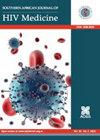与艾滋病毒阴性对照组相比,撒哈拉以南城市艾滋病毒阳性人群呼吸道症状的频率出乎意料地低
IF 1.6
4区 医学
Q4 INFECTIOUS DISEASES
引用次数: 5
摘要
慢性呼吸道疾病和呼吸道感染在艾滋病毒阳性人群中很常见。hiv阳性的人比hiv阴性的人有更多的呼吸道症状,如咳嗽和呼吸困难,这似乎是合理的。本研究旨在确定非洲城市艾滋病毒阳性人群中呼吸道症状的频率。方法2016-2017年在南非约翰内斯堡进行横断面研究。包括四组参与者:hiv阳性参与者(1)尚未接受抗逆转录病毒治疗(ART),(2)接受一线抗逆转录病毒治疗,(3)接受二线抗逆转录病毒治疗,(4)年龄和性别匹配的hiv阴性对照组。收集了有关社会人口统计学、呼吸道危险因素和呼吸道症状的数据。进行逻辑回归分析以确定各组之间呼吸道症状是否不同,并确定与症状相关的决定因素。结果共纳入547名参与者,其中62%为女性,中位年龄为37岁。在这些患者中,63%(347)为hiv阳性,26%为ART-naïve, 24%接受一线抗逆转录病毒治疗,50%接受二线抗逆转录病毒治疗。咳嗽和/或咳出性咳嗽有27人(5%),喘息有9人(2%),呼吸困难有118人(22%)。在调整年龄和性别后,这些症状的频率没有因艾滋病毒状况而异。呼吸困难与年龄、女性、肥胖、呼吸道感染史和气道过度反应史有关。结论除呼吸困难外,本研究人群呼吸系统症状发生率较低。艾滋病毒阳性的参与者,无论是否接受抗逆转录病毒治疗,都不会比艾滋病毒阴性的参与者出现更多的症状。本文章由计算机程序翻译,如有差异,请以英文原文为准。
Unexpected low frequency of respiratory symptoms in an HIV-positive urban sub-Saharan population compared to an HIV-negative control group
Background Chronic respiratory illnesses and respiratory infections are common in HIV-positive populations. It seems reasonable that HIV-positive people experience more respiratory symptoms, such as coughing and breathlessness, than those who are HIV-negative. Objectives This study aims to determine the frequency of respiratory symptoms in an urban African HIV-positive population. Method A cross-sectional study was conducted in Johannesburg, South Africa, in 2016–2017. Four groups of participants were included: HIV-positive participants (1) not yet on antiretroviral therapy (ART), (2) on first-line ART, (3) on second-line ART and (4) age- and sex-matched HIV-negative controls. Data were collected on socio-demographics, respiratory risk factors and respiratory symptoms. A logistic regression analysis was performed to determine if respiratory symptoms differed between groups and to identify determinants associated with symptoms. Results Overall, 547 participants were included, of whom 62% were women, with a median age of 37 years. Of these patients, 63% (347) were HIV-positive, 26% were ART-naïve, 24% were on first-line ART and 50% were on second-line ART. Cough and/or productive cough was reported by 27 (5%), wheezing by 9 (2%) and breathlessness by 118 (22%) of the participants. The frequency of these symptoms did not differ by HIV status after adjustment for age and sex. Breathlessness was associated with age, female sex, obesity, a history of respiratory infection and a history of airway hyper-reactivity. Conclusion The frequency of respiratory symptoms was low in our study population except for breathlessness. HIV-positive participants, whether or not on ART, did not experience more symptoms than HIV-negative participants.
求助全文
通过发布文献求助,成功后即可免费获取论文全文。
去求助
来源期刊
CiteScore
2.80
自引率
11.80%
发文量
41
审稿时长
>12 weeks
期刊介绍:
The Southern African Journal of HIV Medicine is focused on HIV/AIDS treatment, prevention and related topics relevant to clinical and public health practice. The purpose of the journal is to disseminate original research results and to support high-level learning related to HIV Medicine. It publishes original research articles, editorials, case reports/case series, reviews of state-of-the-art clinical practice, and correspondence.

 求助内容:
求助内容: 应助结果提醒方式:
应助结果提醒方式:


